Elevate Your Business with Amazon Q: Intelligent Query Solutions Unleashed
By Devangi Goswami & Piyush Jalan / Jan 16, 2024
Table of Contents
- Introduction
- Understanding the functionality of Amazon Q
- Feature of Amazon Q
- Amazon Q: Sample Use Cases
- Conclusion
Introduction
Introducing Amazon Q, a cutting-edge generative AI-powered assistant designed exclusively for enterprise applications. Tailored to suit the unique needs of your business, Amazon Q seamlessly engages in conversations, tackles complex problem-solving, generates content, and executes actions by seamlessly accessing your company's diverse information repositories, code bases, and enterprise systems. Engineered to deliver rapid and actionable information, Amazon Q serves as a catalyst for optimizing workflows, expediting decision-making processes, and cultivating innovation within the organizational framework.
Ensuring security and privacy as top priorities, Amazon Q respects existing governance identities, roles, and permissions, personalizing interactions accordingly. Amazon Q is currently available in preview, featuring two pricing plans: Business and Builder.
|
Feature |
Amazon Q Business |
Amazon Q Builder |
|
Monthly Cost per User |
$20 |
$25 |
|
Target Audience |
General business users |
Developers and IT professionals |
|
Expertise in Organization's Knowledge |
Included |
Included |
|
User Permissions Understanding |
Included |
Included |
|
Task Completion Assistance |
Included |
Included |
|
Content Generation |
Included |
Included |
|
Enterprise Guardrails |
Included |
Included |
|
Web Application Access |
Included |
Included |
|
QuickSight Integration |
Included |
Included |
|
AWS Expert Assistance |
Not Included |
Included |
|
Debugging, Testing, and Code Optimization |
Not Included |
Included |
|
Application Troubleshooting |
Not Included |
Included |
|
Feature Development Acceleration |
Not Included |
Included |
|
Code Transformation |
Not Included |
Included |
|
SQL Query Generation |
Not Included |
Included |
|
IDE Integration |
Not Included |
Included |
|
Business and AWS Expertise |
Business Expertise |
Business and AWS Expertise |
|
Enterprise System Connectors |
Over 40 (e.g., S3, Salesforce) |
Over 40 (e.g., S3, Salesforce) |
|
Access in AWS Management Console and IDEs |
Limited |
Extensive |
|
Crisp, Relevant Answers Based on Business Data |
Yes |
Yes |
|
Streamlines Day-to-Day Communications |
Yes |
Yes |
|
Completes Tasks |
Yes |
Yes |
|
Enables Enterprise Guardrails |
Yes |
Yes |
|
Integration with QuickSight |
Yes |
Yes |
|
Code Debugging, Testing, Optimization |
No |
Yes |
|
Feature Development Acceleration |
No |
Yes |
|
Code Transformation Capabilities |
No |
Yes |
|
SQL Query Generation in Redshift |
No |
Yes |
|
Access in AWS Management Console and IDEs |
Limited |
Extensive |
Understanding the functionality of Amazon Q
Amazon Q utilizes the Retrieval Augmented Generation (RAG) technique, merging a retrieval component for document fetching and a generation component. The foundation of this system is a substantial Large Language Model (LLM), trained on an extensive corpus.
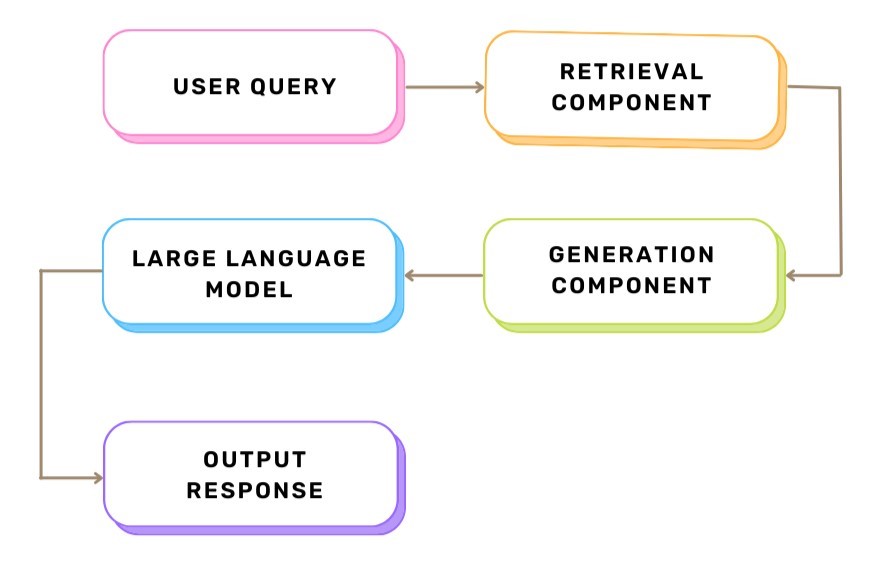
Let's delve into a systematic breakdown of the operational workflow of Amazon Q:
- User Query:
The process with Amazon Q begins when a user asks a question. The questions can be anything from basic information requests to more complicated problem-solving tasks, depending on what the user needs.
In certain scenarios, particularly when accessing confidential or restricted data, Amazon Q might authenticate the user's identity via an Identity Provider (IdP). This verification process ensures that users can only access information for which they have proper authorization.
- Retrieval Component:
When a user query is received, Amazon Q's retrieval component comes into play. It sifts through indexed documents to locate the most relevant ones corresponding to the query. These documents can exist in diverse formats like .csv, .docx, HTML, JSON, .pdf, plaintext, .ppt, .rtf, and .xlsx. Amazon Q enriches documents during ingestion, syncing them in real-time with the index for up-to-date and comprehensive data access.
The retriever fetches data in real-time from an index during a conversation, and Amazon Q offers retrievers for both Amazon Kendra indexes and native indexes.
- Generation Component:
After finding the right documents, Amazon Q hands them over to the generation component which uses a sophisticated machine learning model called a Large Language Model (LLM).
It puts together information from the documents to create accurate responses. Additionally, guardrails and chat controls allow administrators to define which source Amazon Q can use for generating responses, ensuring the conversation remains within predefined boundaries.
- Large Language Model (LLM):
During this stage, the LLM processes information to generate a response. Leveraging its extensive training, the model comprehends intricate queries and delivers detailed responses by extracting insights from the information retrieved from documents.
- User Response:
The output is an answer that is given back to the user. This answer aims to be straightforward, correct, and directly related to the question the user asked. It's meant to give the user the information or help they were looking for.
Feature of Amazon Q
- Conversational Interface
- Amazon Q sifts through and consolidates data from your entire enterprise, enabling your staff to engage in personalized conversations, pose queries and receive precise responses, collaborate on ideas, condense lengthy reports, create content, and initiate actions.
- Amazon Q provides source references and citations used to generate the response, facilitating the validation of provided responses.
- Amazon Q dynamically utilizes the context within the current conversation, enabling users to pose follow-up questions or reference previous responses in subsequent inquiries. While it can initiate new conversations or sustain ongoing dialogues, it's important to note that Amazon Q does not preserve context across distinct conversations.
- Amazon Q provides a seamless experience by enabling end users to directly upload files into the chat interface. The uploaded file data can then be utilized for various tasks, including summarization, Q&A, or data analysis, enhancing the functionality and utility of the web experience.
- Built-in Connectors
Utilizing connectors simplifies the synchronization of data from diverse content repositories with the Amazon Q index. These connectors can be scheduled for automatic synchronization, ensuring your index is consistently updated with the latest content from the data source. It provides pre-built connectors for over 40 supported data sources, encompassing platforms such as Amazon Simple Storage Service (Amazon S3), Microsoft SharePoint, Salesforce, and Atlassian Confluence.
- Filtering using Document Attribute
Amazon Q introduces a document attribute filtering feature, enabling customization and control of chat responses for end users by leveraging metadata linked to documents. For instance, by specifying the data source type as an attribute, you can ensure that chat responses originate only from a designated source, such as Slack. Additionally, end users can employ attribute filters to narrow down the scope of chat responses based on selected criteria, utilizing structural attributes like document title, author, creation time, update time, and document type.
- Troubleshoot and support
Amazon Q facilitates troubleshooting and support by assisting users in comprehending errors within the AWS Console. It grants access to live support agents, allowing the creation of AWS Support cases and real-time chat sessions within the Amazon Q interface to promptly address queries and resolve issues related to AWS services.
Amazon Q: Sample Use Cases
Here are the sample use-cases on how Amazon Q can be used to address and resolve queries.
A. Query related to CloudTrail setup at an Org level.
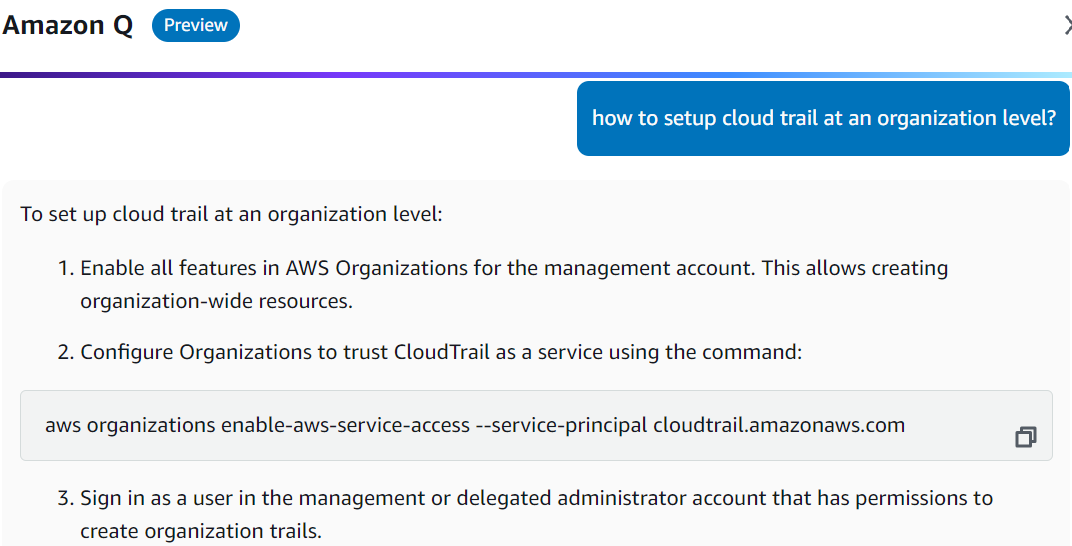
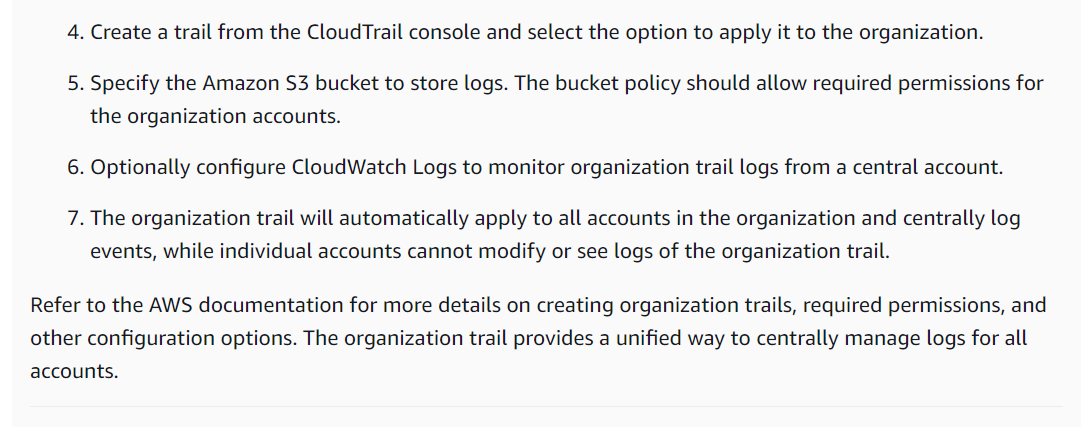
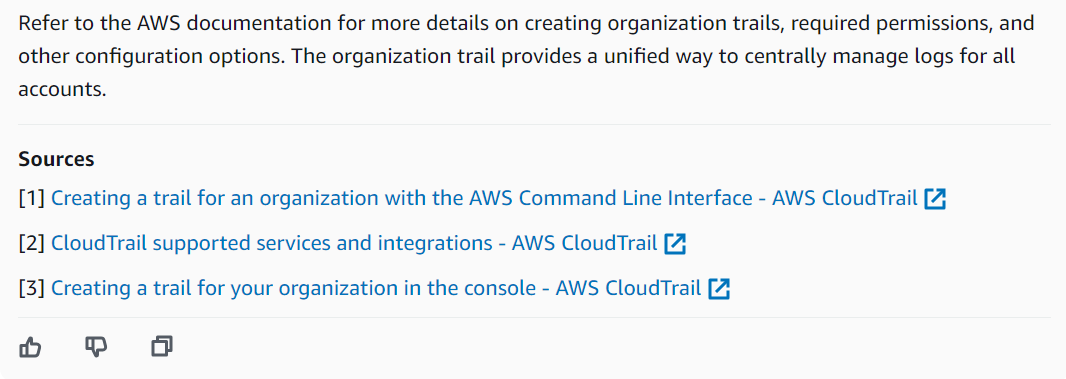
B. Query related to hosting a scalable and highly available web application.
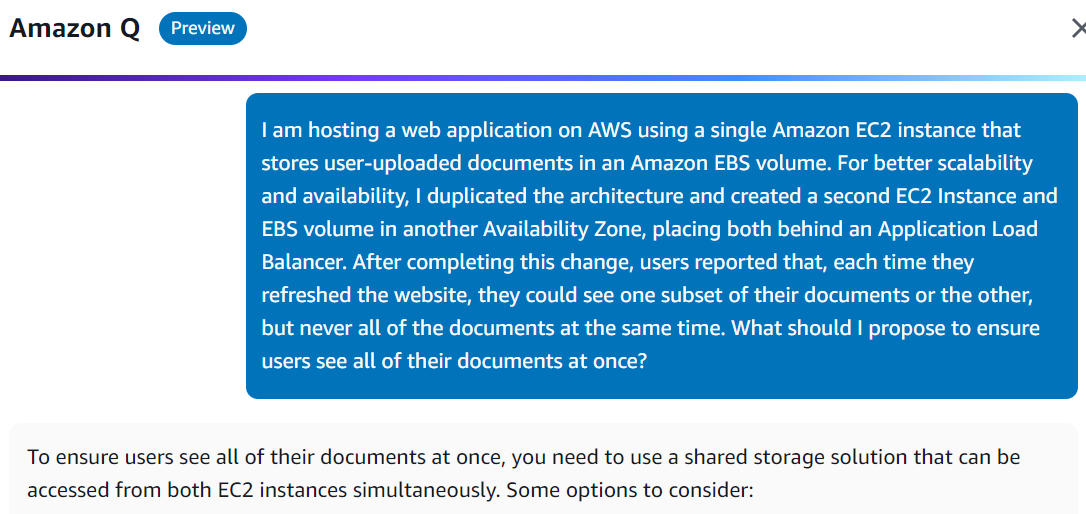
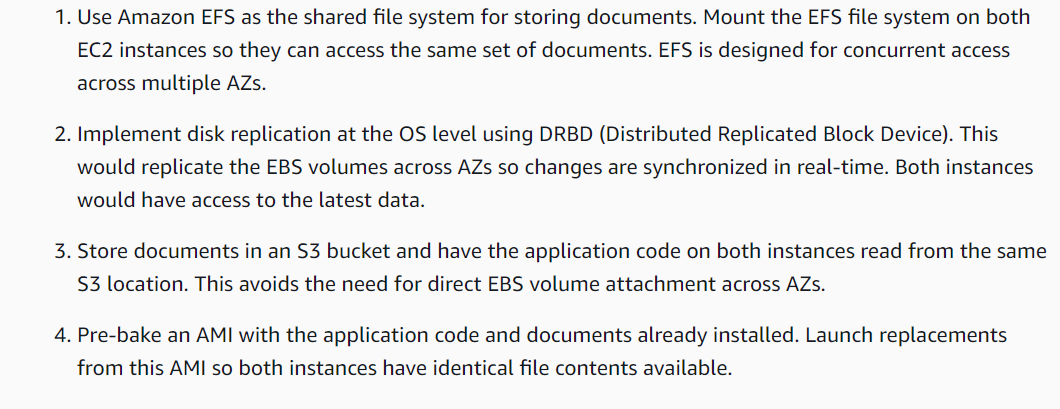
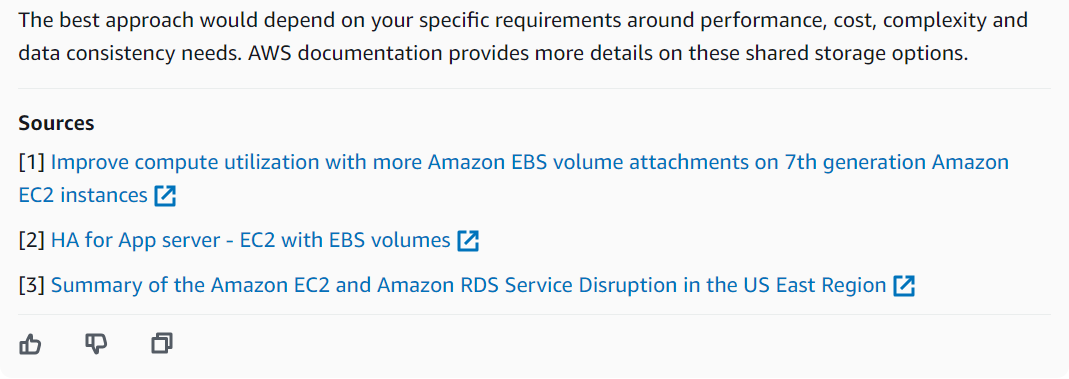
C. Query related to 3-tier serverless web application architecture.
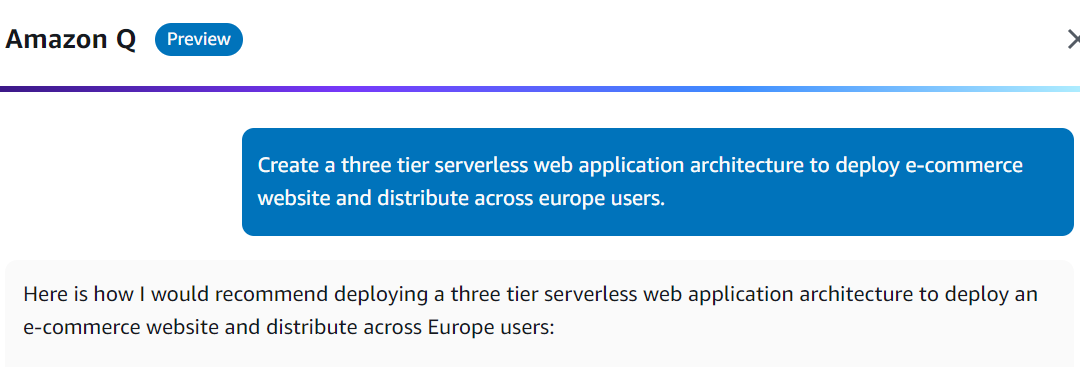

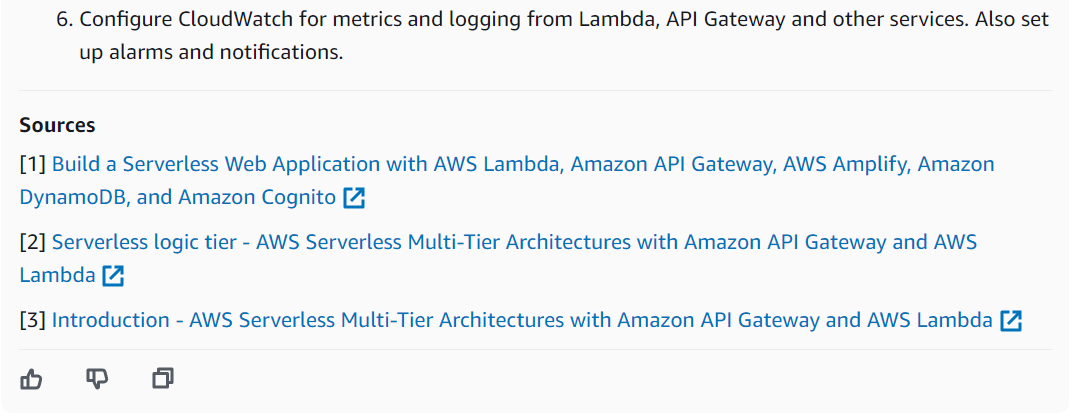
D. Query related to migration of a distributed application to AWS cloud.
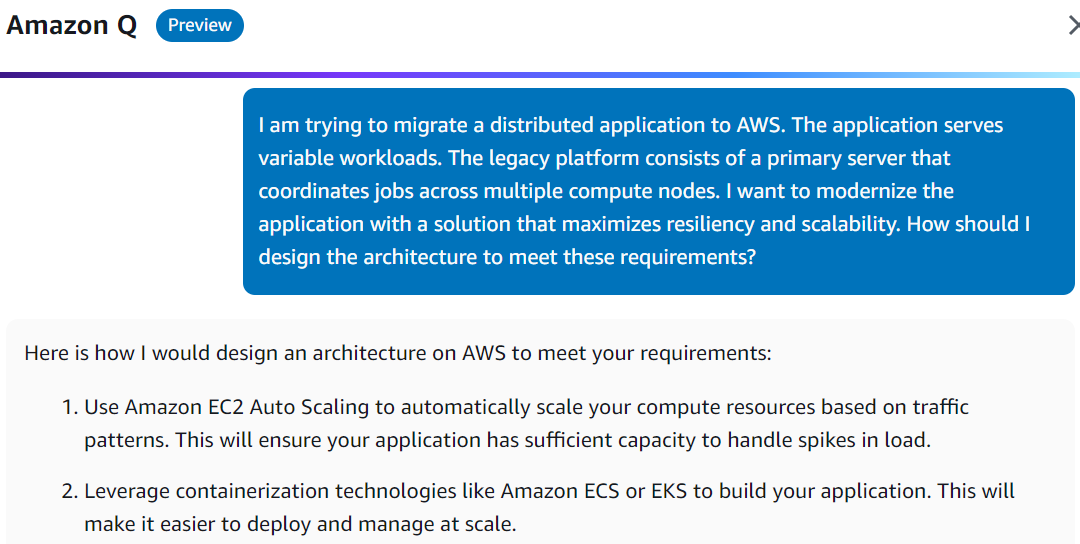
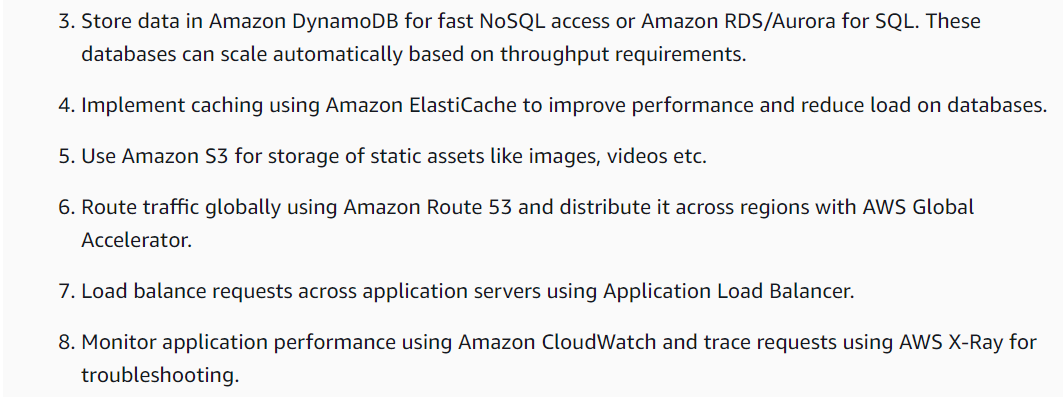

E. Query related to specific storage requirements.
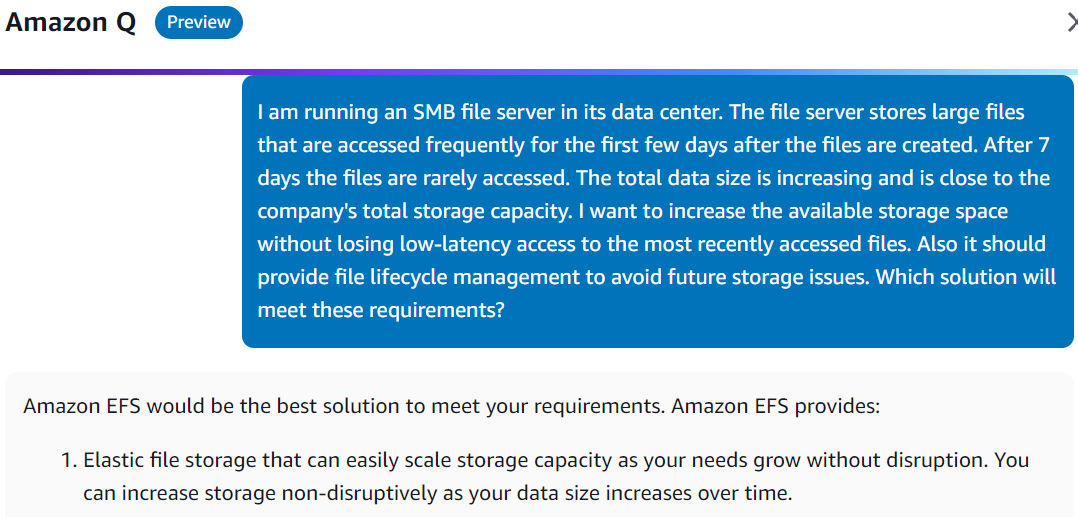

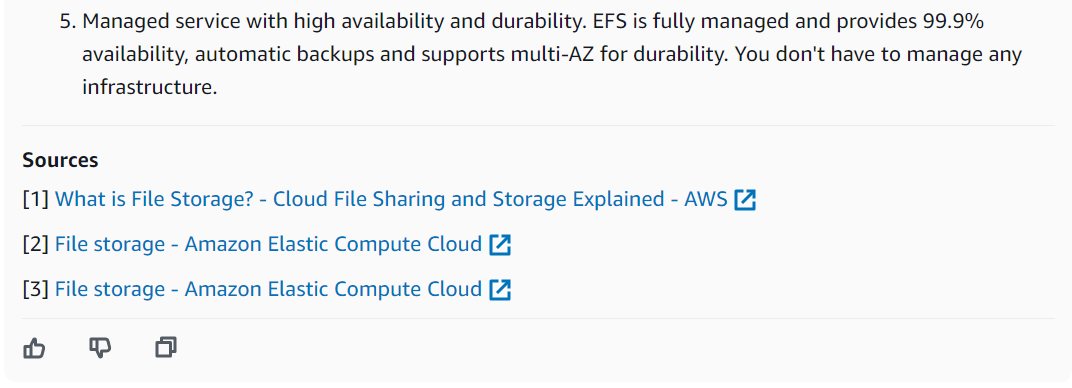
Conclusion
In summary, Amazon Q stands out as a revolutionary tool for businesses, streamlining the process of addressing queries with remarkable ease. Its conversational abilities, intelligent techniques, and rapid responses simplify the intricacies of various tasks. The user-friendly design, coupled with robust security features, ensures a seamless and secure experience. With tailored pricing plans to suit different needs, Amazon Q is poised to transform the way companies approach and resolve questions, providing a user-friendly and efficient solution for diverse business scenarios.




